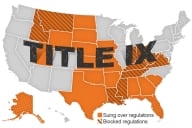You have /5 articles left.
Sign up for a free account or log in.
Student loan guarantee agencies faced an uncertain future in 2010, when the Obama administration and the U.S. Congress eliminated government-backed private lending. With the federal government issuing only direct loans, the guarantee business of insuring bank loans was destined to dry up.
As a result, the more than 30 guarantee agencies have been trying to diversify in recent years.
“A lot of guarantors are going through a strategic plan process,” said James P. Bergeron, president of the National Council of Higher Education Resources, a group that represents the agencies and other organizations involved in lending. “They have no choice but to look at their business models.”
Guarantors are required to be either nonprofits or state-run. The agencies were seen by some as being part of the problem with wasteful private lending, because they received federal fees from collecting on defaulted loans.
The pressure to find new revenue after the move to direct federal loans is a bit less extreme for state agencies, which can fall back on operating grant aid programs, tuition repayment plans or other state-based functions. But experts said large nonprofit guarantors, like USA Funds, Education Credit Management Corporation (ECMC), and the National Student Loan Program, will eventually need to reinvent themselves. Most have been doing so, gradually, for years.
That makes the recent move by ECMC to spend $24 million to buy 56 campuses from Corinthian Colleges, a failing for-profit chain, a little less surprising.
“Our industry is in a wind-down,” said David Hawn, president and CEO of the ECMC Group, an umbrella organization that runs a debt collection service and foundation as well as its guarantee arm.
However, guarantors do have some time to figure out next steps. As of last year, the guaranteed portfolio of outstanding loans from private lenders under the discontinued Federal Family Education Loan Program (FFELP) was $264 billion, according to the U.S. Department of Education. About $60 billion of that amount was in default.
“It’s going to take one to two decades for that to completely get paid off,” said Mark Kantrowitz, publisher of Edvisors.com and an expert on financial aid.
Meanwhile, the agencies continue to earn revenue off the large pot of money. They get a standard fee of 1 percent of the balance of loans for insuring them against default, as well as fees for collection and account maintenance. A 2009 analysis by the New America Foundation found that guarantee agencies receive 16 cents on every dollar they collect in defaulted student loans.
Hawn said ECMC began planning for changes even before the federal shift to direct lending. But the possibility of buying the Corinthian campuses and online programs, which together enroll 39,000 students, didn’t emerge until this spring, when a senior-level employee from the troubled chain called Hawn to float the idea.
The guarantee agency has had lots of contact with former students in the career education sector, both in collecting on defaulted loans and in default prevention.
In addition, Ben Miller, a senior policy analyst at the New America Foundation, has noted ECMC’s special arrangement with the department to act as the handler of $2.9 billion in federal loans that are in bankruptcy proceedings. That role has been controversial, with allegations of overly aggressive collection tactics.
Hawn, however, said ECMC’s experience with borrowers has helped the nonprofit learn about where career schools often fall short. In particular he cites the dim job prospects faced by many of the sector’s former students, who often have trouble paying off their loans.
“We see that every day,” he said. “This gives us an opportunity to make a difference.”
From Philanthropy to Film
Critics say the Education Department has failed to plan adequately for the phasing out of guarantee agencies’ core function. Some have also complained that the department has not figured out how to fill guarantors' historic role in helping borrowers repay and in financial education.
In September the department's Office of Inspector General release an audit on the oversight of guarantors. It found that the feds had underestimated the financial stress some agencies have been facing.
Back in 2011, the department said it would encourage guarantors to propose new services that build on their experience backing loans. While details were fuzzy at the time, the department’s ideas included providing default prevention and financial literacy services to colleges and borrowers.
The major players in the industry have been moving this way.
Kantrowitz said several guarantee agencies have used their expertise and data-collection chops to transition to working on college completion and financial counseling.
“These are organizations that have significant assets,” he said.
For example, United Student Aid Funds, often referred to as USA Funds and one of the largest guarantors, began a reorganization 18 months ago. Led by the group’s new president and chief executive officer, William D. Hansen, a former deputy secretary of education in the George W. Bush administration, the restructuring has been organized around the theme of “completion with a purpose,” meaning the encouragement of both better graduation rates and success after college.
Much of that work is being handled by USA Funds’ philanthropic arm, said Carol D’Amico, a senior vice president with the group. Many of the grants are aimed at better alignment between education and the workforce, she said, as well pushing employers to get “more involved in closing the skills gap.” To that end, the group last month announced a partnership with the U.S. Chamber of Commerce Foundation.
On the revenue side, USA Funds has ramped up its default management work, said D’Amico.
ECMC’s foundation has also become more active. In recent years it has directed $265 million toward underserved students, Hawn said. And that follows $345 million in giving to California’s Cal Grant financial aid program, which ECMC has made as part of its deal to take over the guarantee function for that state.
One Boston-based guarantor has tested its creative mettle. Through a financial management subsidiary, American Student Assistance created a film called “The Red.” Released last year, the four-minute production seeks to encourage young people to be proactive in managing their student debt.
The Texas Guaranteed Student Loan Corporation (TG) has also made changes in recent years. TG is one of the largest state-based guarantors, because it’s located in Texas.
The nonprofit corporation works directly with colleges on default prevention. TG’s consumer-facing side is its “Adventures in Education” website, which predates 2010. The site offers information about career and college planning to students, parents, counselors and others.
TG has continued to develop that service, according to Kristina Tirloni, a spokeswoman for the corporation. One area of focus is encouraging students to complete the Free Application for Federal Student Aid (FAFSA). Tirloni also said TG is ramping up its research division, including collaboration with the National Association of Student Financial Aid Administrators.
New America’s Miller said regulators should keep an eye on guarantors as they branch out, to make sure their new programs are sensible. He said it’s clear many among them plan to stick around for a while, albeit in different forms.
“They’ve got the money to have the ambition,” he said.








